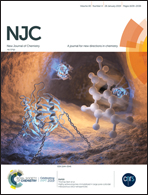A tripodal supramolecular sensor to successively detect picric acid and CN− through guest competitive controlled AIE†
Abstract
Efficient detection of explosives (e.g. picric acid) and toxic compounds (e.g. cyanide) is an important task. Herein, we report a simple and efficient method for the selective and sensitive detection of picric acid (PA) and CN−via a novel guest competitive controlled aggregation-induced emission (AIE) method. First, a tripodal host compound (TG) based on a tris-naphthalimide derivative was designed and synthesized. The TG can self-assemble to a supramolecular system and show blue AIE. Then, we employed the TG-based supramolecular system as a novel supramolecular sensor (S-TG). Interestingly, S-TG could selectively detect PA through a competitive binding interaction, and the detection limit (LOD) of S-TG for PA is 1.19 × 10−8 M. In this process, the self-assembly of S-TG was destroyed and a TG and PA complex (TG–PA) was produced, meanwhile, the AIE of S-TG was quenched. More interestingly, TG–PA could act as a novel supramolecular sensor for the AIE fluorescent ‘turn-on’ detection of CN−, and the LOD of TG–PA for CN− is 7.45 × 10−7 M. Moreover, PA and CN− test kits were prepared by loading S-TG or TG–PA on silica gel plates. These test kits could conveniently and efficiently detect PA or CN− with high selectivity and sensitivity.



 Please wait while we load your content...
Please wait while we load your content...